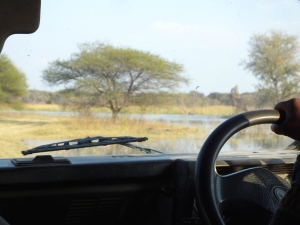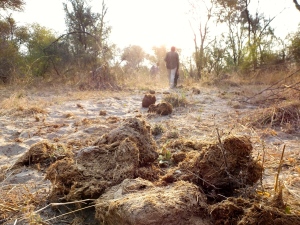As our driver gets out of the truck to assess the depth of the river ahead, we all anxiously peer out the sides to get a glimpse of the flooded road. We have been off-roading through the delta for nearly two hours, leaving Maun early to head to our campsite. Driving over haphazardly piled logs serving as bridges, through deep puddles and around stray livestock, we are nearly at our meeting place for camp.

For most of our drive into the delta, our path was submerged in the winter flood plains. Eventually, we stopped on a dry bank and wait for boats to take us the rest of the way.
Soon, our driver parks the truck on the side of the river, and we all unload food, linens, and bags as our ride floats downstream. Our camp has sent polers on traditional mokoros to take us through the last bit of delta, which is impassable by truck. The mokoros look like long thin canoes, and our guides stand in the back of the boats, pushing them through the shallow waters with a long wooden pole.

Mokoros took us the rest of the way to our watery campsite, deep in the Okavango Delta, one of the most remote places on the planet.
Our camp is set up on the banks of the delta, and each of our tents contains two beds, two trunks, solar powered lanterns, and a private bathroom in the back with an outhouse-style toilet and a hand-pull shower. Once our beds are made and we are settled into our tents, we leave for a bushwalk by mokoro.
We leave the boats on the banks of a small island, and use elephant trails to navigate the thick acacias making up much of the vegetation. Termite mounds are a frequent sight here, and we learn how the mound is made of sand that is excavated to create chambers underground. The taller the termite mound, the deeper the chambers will be, and some termite mounds here have been discovered to have chambers that reach depths of 20 meters.


Elephant dung seems to be everywhere in Botswana – on our bushwalks it is impossible to avoid. Locals here burn it to repel mosquitoes, and in some places it is even used as a source of energy.
After sunset, we have dinner under the stars and our guides perform traditional dances around a campfire. The night ends with roasting marshmallows, and our the European members of our group talk about how they want to introduce their families back home to American s’mores. Luckily, our night of camping is free of thunderstorms.




